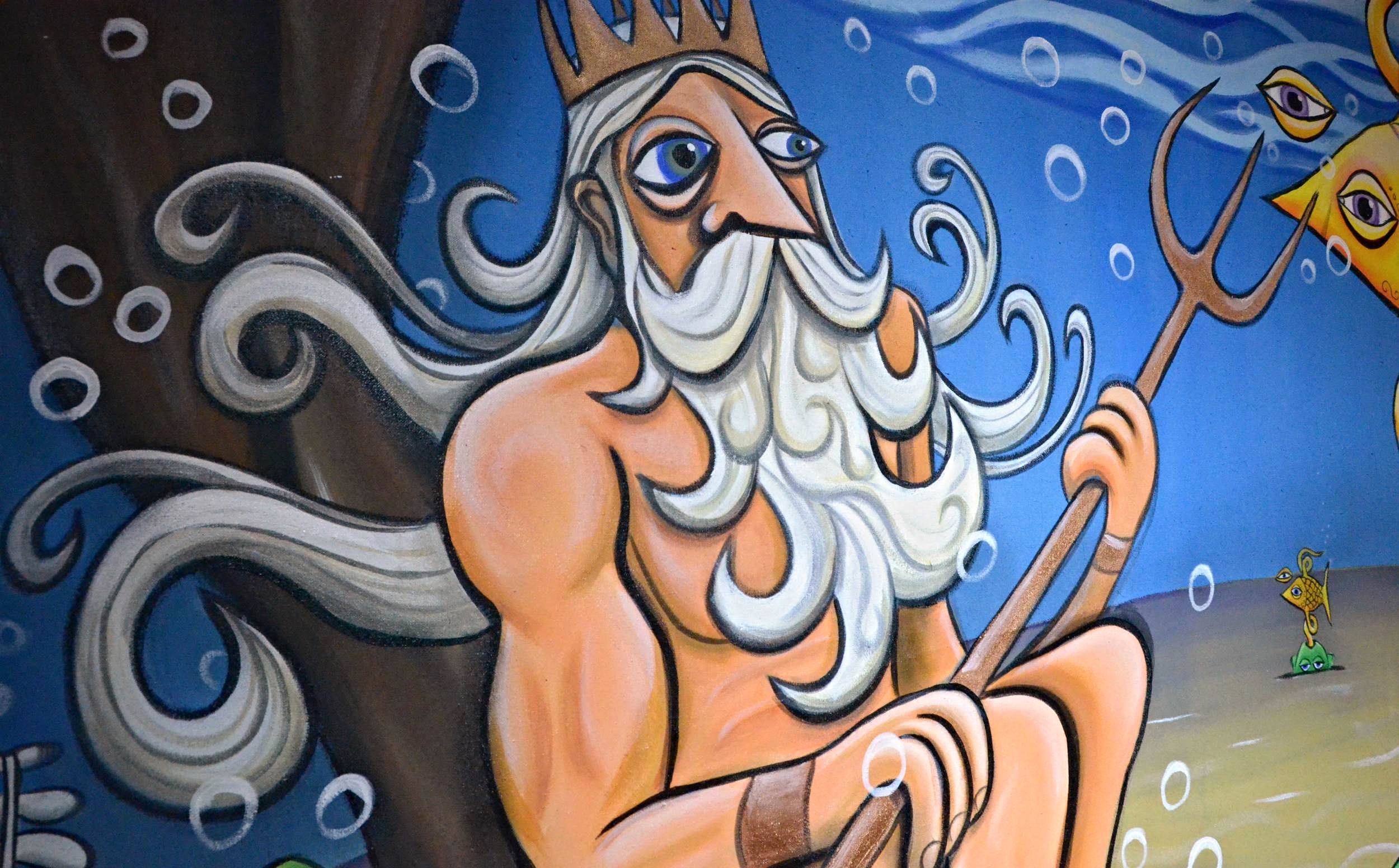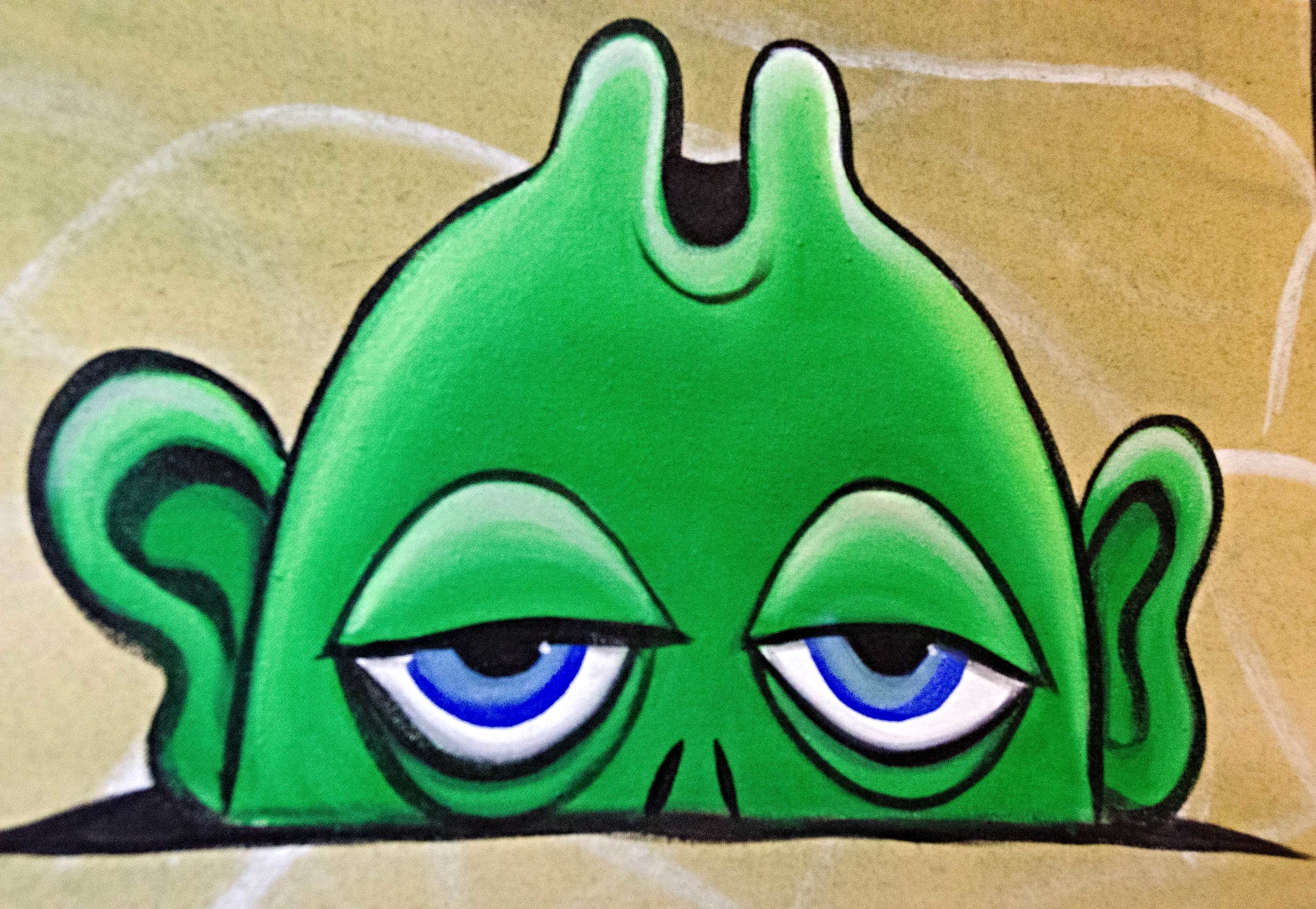




Show Opening
In April, Henry had a showing at Artifact Gallery in Pioneer Square.
(scroll down to watch the gallery opening video and more)
Show Opening
In April, Henry had a showing at Artifact Gallery in Pioneer Square.
(scroll down to watch the gallery opening video and more)
Opening Night at Henry's April Show, "I Still Myth You"
The night was warm on April 2, perfect for a reception to celebrate Henry's first gallery opening in Pioneer Square. Throngs of art devotees, Henry's friends, and the simply curious flowed through the narrow, high-ceilinged space at Artifact Gallery. Henry and his acrylic paintings on canvas held court. As the show's name implies, Henry's paintings featured mythical creatures and deities, including Poseidon, Pan and Ganesh. One of his works, Pray for Us Sinners, a powerful multicultural meditation on loss, made its debut in October at a Seattle Art Museum event.
Selected Works from the Show

Sasquatch
Is Sasquatch an extension of Henry?
Sasquatch
Is Sasquatch an extension of Henry?
The Henry and Sasquatch Bond
Sasquatch, the large hairy Wookie-like creature said to inhabit the forest (especially in the Pacific Northwest), figures prominently in Henry's work. While Native Americans have dubbed Sasquatch-like creatures many names, Henry affectionately refers to them as "Squatches." And whether you believe in the reported sightings, one thing is for sure: You'll see Squatches in and around Henry's studio--especially when he's prepping for the annual Sasquatch Music festival in May. In fact, he's become informally known as the "official Sasquatch artist."
Video music: Look Out Kitty (short version instrumental) / The Mellors

The Sloop Mural
Behind the Sloop Tavern is a mural by Henry, and behind every mural, there's a story.
The Sloop Mural
Behind the Sloop Tavern is a mural by Henry, and behind every mural, there's a story.
The Scoop on the Sloop Mural
In an area chock full of restaurants and bars for every taste from artisanal to mundane, owner Patrick Files is happy to share one of several things that make the Sloop Tavern unique. The Sloop, as it's known to locals, is Ballard's last tavern, meaning that it only serves beer and wine. According to Files, there used to be 40 taverns in Ballard. The Sloop Tavern, which is popular with machine workers, other local workers and sailors, is also a friendly stopover for Henry and his fellow artists.
One day, Henry approached Files about filling the blank exterior wall on the west side, the one facing a gravel alley. After being given the go-ahead, Henry and two other artists painted the mural. In this clip, Files tells the story behind the different characters that appear on the mural, an idea that was hatched by Henry and his friend and one of the fellow mural artists on the mural, Andrew Miller.
Video music: Herrain (Instrumental) / John Shough
Files's Ballardite Litmus Test and Thoughts on Seattle's Changes
Files, who grew up in north Seattle and attending seafood fests, says he has a litmus test to suss out true Ballardites. The test involves answering the following question: Who is the famous accordion player who always played at the Ballard Seafood Fest? The answer? Stan Borreson, who Files refers to as "the man who knew 2,000 songs on the accordion."
As for the changes sweeping Ballard, Files has mixed opinions. "I wish they would have kept some of the more of the original stuff around here," he says. "They did their best to preserve some of the old historic buildings down on Ballard Ave ... The rents have gone up quite a bit so a lot of the more blue-collar workers have been forced to move out of town or north," he adds.
His final thoughts? "Change is going to come, it always happens. You can't stop it, so you have to embrace it a little bit."

Influences and Impact
Who influenced Henry's art and what are people saying about it?
Influences and Impact
Who influenced Henry's art and what are people saying about it?
Early Influences and Evolution
As a child growing up in Montana, Henry was fascinated by illustrators and cartoonists. He counts Dr. Seuss, Shel Silverstein and Jim Unger among his early influences. When he told his grandfather that he wanted to draw cartoons, his grandfather supported the idea but admonished him to make sure that he developed his own original style, rather than copying anyone he admired. Henry took this advice to heart, to the point that his penchant for doing his own thing put him at odds with his art instructors.
As he matured as an artist, Henry has rotated through different phases, exploring a variety of styles and subjects. "I went through a phase of just painting abstract for a few years in my mid-20s, and that was good for me. I learned a lot about composition, how to use color, and different things," he says.
“I just kind of let painting teach me how to paint. I wouldn’t really go into painting with a focus. I would just play with paints and colors and let things kind of come out of that.”
Compliments and Criticism
The style for which Henry is most well-known today, with its bold lines and sweep of bright colors, realistic and fanciful animals, gnomes, wizards, "Squatches" and unicorns have struck his critics (notably former Seattle Post-Intelligencer art critic Regina Hackett) as simplistic, benign, childish and overly cutesy. For his part, Henry has no qualms about appealing to children. In fact, he sees children as a crucial audience for his public art. "It's interesting to see what it's like from a kid's perspective to have these 30-foot paintings that speak to them. They're having a relationship with it. They get it," he says.
Not all is unicorns and rainbows in Henry's work, however. To call his body of work on the whole simplistic is a simplistic critique in itself. Such criticism doesn't take into account the fact that he addresses darker themes and mature content, and he incorporates mythology and multicultural references in his work. His recent April show at Artifact Gallery is a case in point, with works depicting Pan and the emotionally evocative piece Pray for Us Sinners depicting a broader range than for which critics give him credit.
Social Savvy
As with many artists who make a living from their art, Henry has established a presence across multiple social media channels. Here's where you can find him.








